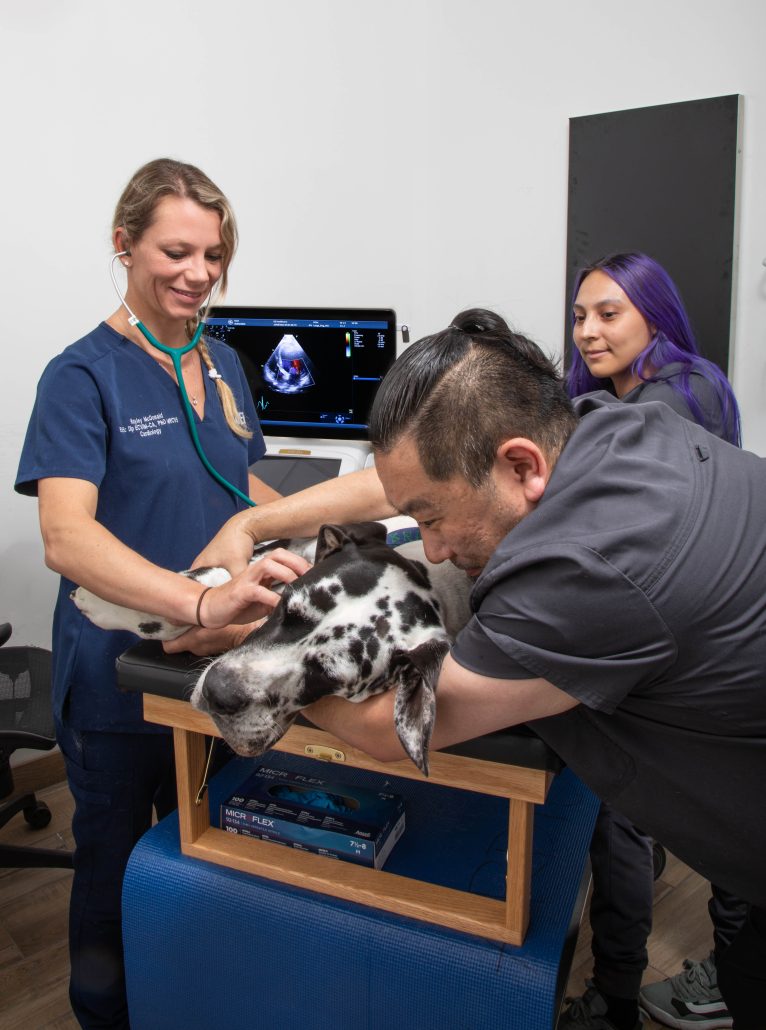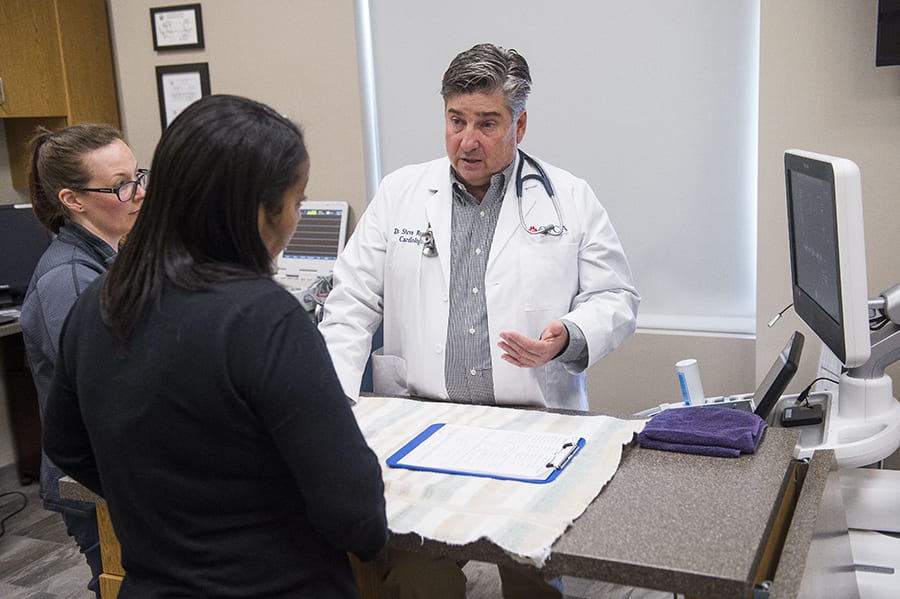The Role of Ultrasound and CT Check in Modern Veterinary Practices: Insights From Experienced Professionals
In modern vet techniques, ultrasound and CT scans considerably improve diagnostic capabilities. These imaging techniques supply important understandings right into animal wellness, directing therapy choices. Experienced experts acknowledge the special benefits of each technique. Ultrasound provides real-time assessments, while CT scans deliver elaborate physiological information. Understanding their applications and functions elevates crucial concerns regarding their influence on client end results and the future of vet diagnostics. What understandings can be gotten from their integrated usage?
Recognizing Ultrasound in Vet Medicine
Ultrasound is a necessary analysis device in vet medication, offering a non-invasive technique to imagine internal frameworks. This imaging method employs high-frequency acoustic waves to develop real-time photos of tissues and body organs, enabling vets to evaluate conditions without medical treatment. Usual applications include assessing the heart, liver, kidneys, and reproductive body organs, in addition to keeping track of pregnancies.The procedure is relatively quick and can be performed in various settings, making it an accessible alternative for vets. Unlike radiography, ultrasound supplies comprehensive information about soft cells and blood flow, which is essential for exact diagnoses.Veterinary experts rely upon ultrasound to discover irregularities such as growths, cysts, and liquid accumulation. Its capability to assist biopsies and other treatments further improves its energy in medical practice. By offering a reliable and secure means to take a look at interior makeup, ultrasound has actually come to be a keystone of modern-day vet diagnostics.
The Advantages of CT Scans for Animal Diagnostics
CT checks deal substantial benefits in veterinary diagnostics by providing boosted precision in determining internal problems (Cancer Veterinary Near Me). As a non-invasive imaging strategy, they assure the safety and security and comfort of animals during examinations. Furthermore, CT scans assist in a detailed evaluation of internal structures, allowing for extra efficient treatment planning
Enhanced Analysis Accuracy
Improvements in imaging technology have actually greatly improved analysis precision in vet medicine, especially via making use of CT scans. These scans supply detailed cross-sectional pictures of an animal's inner structures, allowing veterinarians to recognize abnormalities with accuracy. The high resolution and three-dimensional capabilities of CT imaging assist in the discovery of conditions such as growths, cracks, and interior bleeding that may be missed out on with traditional imaging techniques. Additionally, CT scans can assist in pre-surgical preparation by providing a complete view of anatomical partnerships. This level of information not just improves the accuracy of medical diagnoses yet additionally help in customizing effective treatment strategies. As a result, the integration of CT modern technology into veterinary practices is transforming the landscape of pet healthcare, enhancing outcomes for individuals.
Non-Invasive Imaging Method
The introduction of non-invasive imaging methods has actually transformed pet diagnostics, with CT checks arising as a popular device in veterinary practices. These scans provide high-resolution, cross-sectional photos of a pet's inner frameworks, permitting vets to analyze intricate problems without the requirement for invasive procedures. The benefits of CT scans include their capacity to spot tumors, fractures, and internal bleeding with amazing precision. Furthermore, they assist in the analysis of soft cells and organs, improving analysis capacities. The rate of CT scanning enables quick decision-making, which is essential in emergency situation scenarios. By minimizing stress and anxiety and pain for the animal, CT scans contribute to a much more humane strategy to diagnostics, eventually improving therapy results and progressing veterinary treatment.
Comprehensive Internal Assessment
An extensive inner evaluation is vital for exact diagnosis and effective therapy in veterinary medication. CT scans deal considerable benefits in this regard, giving in-depth cross-sectional photos of a pet's internal structures. This innovative imaging technique improves visualization of complicated physiological regions, allowing vets to determine irregularities such as tumors, cracks, and interior blood loss with higher precision. On top of that, CT scans help with the evaluation of conditions that might be challenging to diagnose via typical techniques. The speed and precision of CT imaging additionally add to prompt interventions, boosting client end results. As veterinary methods increasingly integrate CT modern technology, the benefits of considerable internal analyses end up being evident, strengthening the importance of this device in modern-day vet diagnostics.
Comparing Ultrasound and CT Imaging Techniques
While both ultrasound and CT imaging serve important functions in vet diagnostics, each technique offers unique benefits and constraints that can affect medical decision-making. Ultrasound is specifically valued for its real-time imaging capabilities, allowing veterinarians to observe dynamic physical procedures. This technique is non-invasive, mobile, and does not involve ionizing radiation, making it a much safer alternative for both animals and medical professionals. Ultrasound might have restrictions in imagining certain physiological frameworks or deep tissues.Conversely, CT imaging gives in-depth cross-sectional here are the findings views of the body, permitting for exact localization of irregularities. It masters reviewing complicated organs and frameworks, particularly in the thorax and abdominal area. CT scans call for sedation or anesthesia in several situations and entail exposure to ionizing radiation. Eventually, the choice between ultrasound and CT relies on the particular professional situation, the location of interest, and the seriousness of the analysis requirements.
Case Studies: Effective Diagnoses Via Imaging
Situation researches illustrate the considerable enhancements in diagnostic precision attained with sophisticated imaging modern technologies like ultrasound and CT scans in vet practices. These improvements not only improve the discovery of numerous problems but also help with effective and timely therapy plans. Analyzing certain instances can highlight the transformative effect of these imaging methods on veterinary medication.
Analysis Accuracy Improvements

Imaging Technology Advancements
As vet imaging modern technology continues to progress, its influence on analysis capacities becomes progressively noticeable. Current study highlight the effective application of innovative ultrasound and CT check techniques in determining intricate problems. For circumstances, a vet clinic utilized high-resolution CT scans to diagnose a rare type of lung cancer in a pet dog, which standard imaging had actually missed out on. An ultrasound exam disclosed a stomach mass in a feline, triggering timely surgical intervention and a favorable result. These innovations not just improve diagnostic accuracy yet likewise allow veterinarians to develop targeted treatment strategies. By leveraging sophisticated imaging modern technologies, vet experts are noticeably enhancing individual care, leading to a lot more reliable administration of various health problems in animals.
The Duty of Imaging in Emergency Situation Veterinary Treatment
Imaging plays a crucial function in emergency vet care, giving veterinarians with important information required to make rapid, enlightened decisions. In immediate circumstances, methods like ultrasound and CT scans make it possible for professionals to rapidly evaluate an animal's interior structures, identifying crucial problems such as interior blood loss, cracks, or organ problems. These imaging modalities permit real-time evaluations, promoting timely treatments that can be life-saving. As an example, ultrasound is vital for assessing soft cells injuries and conditions like fluid buildup, while CT checks offer comprehensive photos of complex anatomical frameworks, essential for identifying injury instances. The rate and precision of these imaging techniques enhance the veterinarian's ability to develop reliable treatment plans, making sure the finest possible end results for their individuals. The combination of advanced imaging modern technologies right into emergency veterinary techniques is not only advantageous but significantly essential, as it boosts diagnostic capabilities and boosts general animal treatment during crucial minutes.

Training and Knowledge in Veterinary Imaging
Advanced imaging methods such as ultrasound and CT scans are crucial for reliable veterinary treatment, the effective execution of these innovations greatly depends on the training and competence of vet specialists. Skilled use of imaging tools needs comprehensive understanding of composition, pathology, and the concepts underlying each method. Vet specialists have to go through specific training to accurately analyze imaging outcomes, which is important for identifying conditions and planning treatment.Certifications and continuing education in veterinary imaging improve the skills of experts, enabling them to remain upgraded with technical developments. Collaboration between radiologists and veterinarians frequently brings about enhanced analysis precision, as specialists can give insights into complicated situations. In addition, useful experience in dealing with imaging equipment fosters confidence in its application. Inevitably, the high quality of veterinary imaging services is straight correlated to the level of training and competence possessed by the professionals making use of these crucial analysis tools.
Future Trends in Diagnostic Imaging for Animals
With the fast investigate this site improvements in innovation, veterinary analysis imaging is poised for considerable advancement in the coming years. Emerging fads indicate a change in the direction of more mobile and obtainable imaging methods, such as handheld ultrasound tools, which might enhance area diagnostics. Additionally, the assimilation of expert system is anticipated to revolutionize photo analysis, enabling quicker and much more exact interpretations of results.Moreover, innovations in 3D imaging methods and calculated tomography will supply veterinarians with even more comprehensive sights of animal composition, leading to enhanced therapy plans. Online fact modern technology may additionally play a function in medical preparation and education, providing vets a distinct perspective on complicated cases.As telemedicine continues to grow, remote appointments facilitated by diagnostic imaging will certainly become extra common, enabling professionals to aid family doctors in real-time. On the whole, these trends are readied to improve the effectiveness and performance of vet treatment, inevitably boosting pet outcomes.
Frequently Asked Inquiries
Just How Much Do Ultrasound and CT Checks Price in Vet Clinics?
The costs of ultrasound and CT scans in veterinary clinics usually vary from $300 to $1,500, depending upon aspects such as area, facility type, and certain procedures required for the animal's medical diagnosis and therapy.

Exist Any Risks Connected With Ultrasound and CT Checks for Pet Dogs?
Ultrasound and CT scans generally position very little threats to pet dogs. However, potential concerns include sedation reactions and exposure to anesthetics. Ultrasound For Dogs. Veterinarians very carefully evaluate each instance to mitigate any kind of threats related to these diagnostic treatments
The Length Of Time Do Ultrasound and CT Procedures Normally Take?
Ultrasound treatments normally take about 30 minutes to an hour, depending on the complexity. CT scans, being even more thorough, normally need 30 minutes to 90 minutes, consisting of prep work and healing time for the animal.
Can All Veterinarians Perform Ultrasounds and CT Scans?
Not all veterinarians can perform ultrasounds and CT scans. Specialized training and certification are often called for to ensure proficiency in these advanced imaging strategies, which may limit their accessibility to veterinarians with additional credentials and resources.
What Sorts Of Pets Benefit Most From These Imaging Techniques?
Specific animal varieties, especially felines and dogs, benefit greatly from ultrasound and CT scans. These imaging strategies improve analysis accuracy for problems like growths, inner injuries, and body organ irregularities, leading to better treatment end results and client treatment. The high resolution and three-dimensional capabilities of CT imaging assist in the detection of conditions such as lumps, fractures, and inner bleeding that may be missed out on with conventional imaging methods. Situation studies show the significant enhancements in analysis accuracy accomplished via advanced imaging innovations like ultrasound and CT scans in vet practices. Improving diagnostic precision in vet practices has been substantially assisted by developments in imaging innovations such as ultrasound and CT scans. Innovative imaging techniques such as ultrasound and CT scans are necessary for reliable veterinary care, the successful application of these innovations greatly depends on the training and proficiency of veterinary specialists. Vet specialists must go through specific training to precisely translate imaging results, which is important for detecting problems and planning treatment.Certifications and proceeding education in veterinary imaging enhance the skills of specialists, enabling them to stay updated with technological advancements.